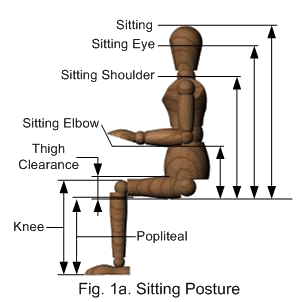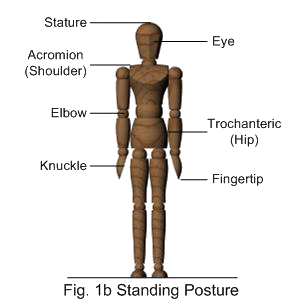|
There are many body measurements that can be
taken but the more that are taken the more time the whole process takes
and the more expensive it becomes. Large scale
anthropometric surveys to establish data for a particular population are
very rare because of the expense involved.
For most practical purposes, existing data
has to be used and modified to get a good estimate of the data needed by
methods discussed later. Should it be necessary to conduct a survey the
population to be sampled, called the target population, must be defined
very clearly and then a random sample needs to be
chosen from that population. In practice it is very difficult to
get random samples because, apart from the expense involved, all sorts
of people will not participate in such surveys, and cannot be compelled
to do so. There are many methods of sampling but whichever method is
used the aim should be to end up with a sample that is representative of
the whole population.
The simplest sort of measurements and the
most commonly available are static measurements. These are usually
defined as a distance measured between two points on the body, though
there are also curvatures and circumferences. In order to be able to
compare data from different populations and to ensure that future users
of the data will know exactly what was measured, standard anthropometric
postures for standing and sitting are used for taking measurements.
In
the standard standing posture, for example the person must be in a free
standing position, erect at full height with eyes looking straight
ahead, with relaxed shoulders and arms down to the sides (Fig. 1). The
person should wear as little clothing as is practical so that points of
the body are measured and not points on clothing.
For the seated person
measurements are taken relative to the horizontal and vertical reference
planes that represent the seat surface and back of the seat. The point
where these two planes and the median plane of the body intersect is
called the seat reference point (SRP) (Fig. 1).


Fig. 1
Various heights shown for standard anthropometric postures
Some of the points used to take measurements
are bony landmarks on the body, like the acromium which is the bony
prominence at the top of the shoulder, or the trochanterion, which is
the bony prominence at the side of the hip (Fig. 1). Other measurements
are made on soft tissue like bust or buttocks and circumferences are on
soft tissue. The methods and devices used to take static measurements
are exactly what you would expect. Measuring grids (like graph paper)
can be attached to vertical walls at right angles to each other and the
person stood or sat against the grids may then be measured by projection
of the desired dimension onto the grid, using, for example, various
sliding flat surfaces. More simply but slower, a range of hand held
instruments may be used.
For larger distances between points a large
ruler, called an anthropometer with sliding branches at right angles or
with curve branches may be used. For dimensions such as breadths, depths
and diameters, a spreading caliper is used, and for smaller dimension,
like finger lengths a small sliding compass is used. In addition there
are many special instruments to measure things like finger diameter,
grip diameter, and thickness of skinfolds. There are also much more
sophisticated systems available, using photography, holography and laser
measuring devices. Static data is fine for defining overall dimensions
for a design but people move about and another sort of data is dynamic.
The data will show at least three
percentiles, usually the 5th, 50th and 95th and give the standard
deviation for each dimension so that any percentile may be calculated.
Because of the expense and the difficulty of getting people to volunteer
to be measured, much of the data available is from
military sources. Relatively little data is available for
civilians and is often limited to a few easy to obtain measures such as
height and weight. There are techniques such as ratio scaling, where the
known ratios between dimensions for one population for which data exists
can be applied to estimate unknown dimensions for another population.
Also, some body dimensions are highly correlated
with each other, like stature and eye height, so that an unknown
dimension can be estimated from a known dimension. However there are
many dimensions, like stature and waist
circumference, that are not highly correlated with each other.
|








